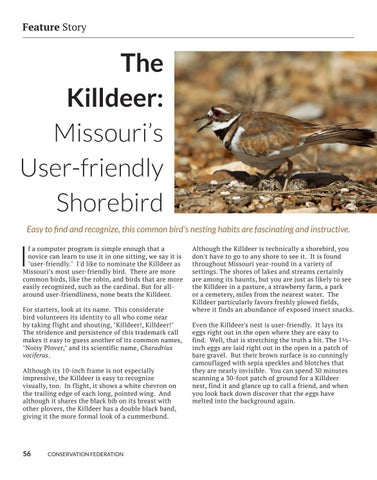Feature Story
The Killdeer: Missouri’s User-friendly Shorebird Easy to find and recognize, this common bird's nesting habits are fascinating and instructive.
I
f a computer program is simple enough that a novice can learn to use it in one sitting, we say it is "user-friendly." I'd like to nominate the Killdeer as Missouri’s most user-friendly bird. There are more common birds, like the robin, and birds that are more easily recognized, such as the cardinal. But for allaround user-friendliness, none beats the Killdeer. For starters, look at its name. This considerate bird volunteers its identity to all who come near by taking flight and shouting, "Killdeer!, Killdeer!" The stridence and persistence of this trademark call makes it easy to guess another of its common names, "Noisy Plover," and its scientific name, Charadrius vociferus. Although its 10-inch frame is not especially impressive, the Killdeer is easy to recognize visually, too. In flight, it shows a white chevron on the trailing edge of each long, pointed wing. And although it shares the black bib on its breast with other plovers, the Killdeer has a double black band, giving it the more formal look of a cummerbund.
56
CONSERVATION FEDERATION
Although the Killdeer is technically a shorebird, you don't have to go to any shore to see it. It is found throughout Missouri year-round in a variety of settings. The shores of lakes and streams certainly are among its haunts, but you are just as likely to see the Killdeer in a pasture, a strawberry farm, a park or a cemetery, miles from the nearest water. The Killdeer particularly favors freshly plowed fields, where it finds an abundance of exposed insect snacks. Even the Killdeer's nest is user-friendly. It lays its eggs right out in the open where they are easy to find. Well, that is stretching the truth a bit. The 1½inch eggs are laid right out in the open in a patch of bare gravel. But their brown surface is so cunningly camouflaged with sepia speckles and blotches that they are nearly invisible. You can spend 30 minutes scanning a 30-foot patch of ground for a Killdeer nest, find it and glance up to call a friend, and when you look back down discover that the eggs have melted into the background again.
